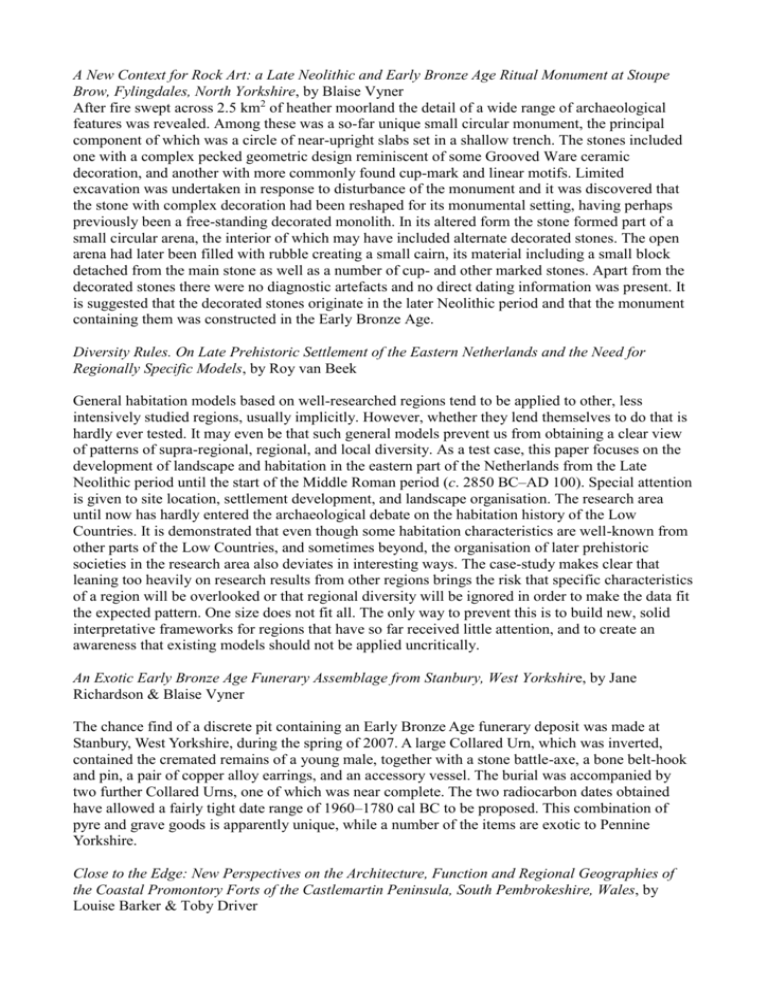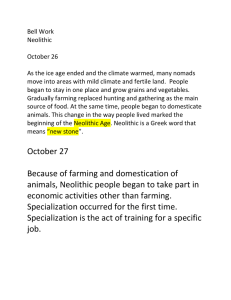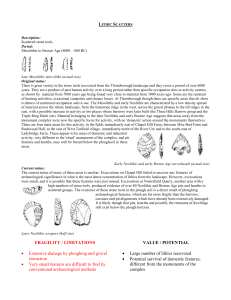Abstracts - The Prehistoric Society
advertisement

A New Context for Rock Art: a Late Neolithic and Early Bronze Age Ritual Monument at Stoupe Brow, Fylingdales, North Yorkshire, by Blaise Vyner After fire swept across 2.5 km2 of heather moorland the detail of a wide range of archaeological features was revealed. Among these was a so-far unique small circular monument, the principal component of which was a circle of near-upright slabs set in a shallow trench. The stones included one with a complex pecked geometric design reminiscent of some Grooved Ware ceramic decoration, and another with more commonly found cup-mark and linear motifs. Limited excavation was undertaken in response to disturbance of the monument and it was discovered that the stone with complex decoration had been reshaped for its monumental setting, having perhaps previously been a free-standing decorated monolith. In its altered form the stone formed part of a small circular arena, the interior of which may have included alternate decorated stones. The open arena had later been filled with rubble creating a small cairn, its material including a small block detached from the main stone as well as a number of cup- and other marked stones. Apart from the decorated stones there were no diagnostic artefacts and no direct dating information was present. It is suggested that the decorated stones originate in the later Neolithic period and that the monument containing them was constructed in the Early Bronze Age. Diversity Rules. On Late Prehistoric Settlement of the Eastern Netherlands and the Need for Regionally Specific Models, by Roy van Beek General habitation models based on well-researched regions tend to be applied to other, less intensively studied regions, usually implicitly. However, whether they lend themselves to do that is hardly ever tested. It may even be that such general models prevent us from obtaining a clear view of patterns of supra-regional, regional, and local diversity. As a test case, this paper focuses on the development of landscape and habitation in the eastern part of the Netherlands from the Late Neolithic period until the start of the Middle Roman period (c. 2850 BC–AD 100). Special attention is given to site location, settlement development, and landscape organisation. The research area until now has hardly entered the archaeological debate on the habitation history of the Low Countries. It is demonstrated that even though some habitation characteristics are well-known from other parts of the Low Countries, and sometimes beyond, the organisation of later prehistoric societies in the research area also deviates in interesting ways. The case-study makes clear that leaning too heavily on research results from other regions brings the risk that specific characteristics of a region will be overlooked or that regional diversity will be ignored in order to make the data fit the expected pattern. One size does not fit all. The only way to prevent this is to build new, solid interpretative frameworks for regions that have so far received little attention, and to create an awareness that existing models should not be applied uncritically. An Exotic Early Bronze Age Funerary Assemblage from Stanbury, West Yorkshire, by Jane Richardson & Blaise Vyner The chance find of a discrete pit containing an Early Bronze Age funerary deposit was made at Stanbury, West Yorkshire, during the spring of 2007. A large Collared Urn, which was inverted, contained the cremated remains of a young male, together with a stone battle-axe, a bone belt-hook and pin, a pair of copper alloy earrings, and an accessory vessel. The burial was accompanied by two further Collared Urns, one of which was near complete. The two radiocarbon dates obtained have allowed a fairly tight date range of 1960–1780 cal BC to be proposed. This combination of pyre and grave goods is apparently unique, while a number of the items are exotic to Pennine Yorkshire. Close to the Edge: New Perspectives on the Architecture, Function and Regional Geographies of the Coastal Promontory Forts of the Castlemartin Peninsula, South Pembrokeshire, Wales, by Louise Barker & Toby Driver Many of Pembrokeshire’s 58 coastal promontory forts are iconic and well-known monuments. They occur in a density unparalleled in the rest of Wales. Morphology is highly variable, as is Pembrokeshire’s ever-changing coastal geology, from resistant granite in the north to softer limestones and sandstones in the south. New surveys by the Royal Commission on the Ancient and Historical Monuments of Wales (RCAHMW) of three promontory forts on the Castlemartin Peninsula in south Pembrokeshire – Linney Head Camp, Flimston Bay Camp, and Greenala Point Fort – have demonstrated how complex and different each of these sites is and, as part of a wider study of the Castlemartin Peninsula, have raised new questions concerning our understanding of this monument type. Dominating and shaping the discussion is our modern-day perception that coastal promontory forts are remote, exposed, and dangerous places. How much is this an accurate portrayal of prehistoric attitudes to the sea or was their outlook more mundane and practical? Did coastal promontory forts share identical functions as defended domestic/agricultural settlements, exploiting a seaward position for ease of defence, or were they indeed special places? Their highly variable architecture – coupled with some unusual characteristics of topography and setting – may indicate varying functions among even closely neighbouring sites. The evidence revealed from the study suggests that some coastal promontory forts may have been exclusively used for ceremonial or seasonal activity, while others may have been quite different prestigious residences investing heavily in monumental architecture. In conclusion, there is considerable merit in the detailed resurvey and re-investigation of coastal promontory forts within distinct regional groups to shed new light on our understanding of this later prehistoric monument type. On the Beach: New Discoveries at Harlyn Bay, Cornwall, by Andy M. Jones, Jane Marley, Henrietta Quinnell, & Steve Hartgroves In 1990 a stone covered pit containing a Trevisker Ware vessel was found eroding from the cliffs at Harlyn Bay and excavated. The vessel contained cremated bone from several individuals with some animal bone, quartz pebbles, and a small bronze pendant. A radiocarbon date on the cremated bone fell in the range 2120–1880 cal BC and is a valuable addition to the small number of securely-dated Early Bronze Age burials in Cornwall with metalwork associations. This early date also makes a major contribution to the debate on the sequence of Trevisker Ware as the vessel, of gabbroic clay, has a band of incised chevron decoration. Lipid residue analysis showed traces of ruminant dairy fat. This paper examines the significance of unmounded burial sites in Cornwall and also assesses the importance of Early Bronze Age burials around Harlyn Bay which have produced an unusually wide range of artefacts. A Re-appraisal of the Evidence for Violence in the Late Iron Age Human Remains from Maiden Castle Hillfort, Dorset, England, by Rebecca C. Redfern The human remains excavated by Sir Mortimer Wheeler from Maiden Castle hillfort (Dorset, England) were recorded by the author in the first re-examination of the sample since Wheeler’s 1943 publication. This study focuses on the osteological evidence for trauma, and employed bioarchaeological, clinical, and forensic methods to identify and interpret the skeletal evidence for ante- and peri-mortem fractures, blunt-force cranial trauma, and sharp and blunt projectile injuries. Examination of the human remains found overwhelming evidence for targeted blows to the head and body, assault injuries, and over-kill. Skeletal evidence for trauma was identified in adolescent and adult individuals, suggesting that both sexes and older subadults were exposed to and/or engaged in martial activity during the Late Iron Age. The presence of healed direct-force traumas suggests that many had survived previous episodes of interpersonal violence. The higher crude prevalence rates of trauma in the late Iron Age Belgic war cemetery and Iron Age C groups suggest that these burials reflect multiple episodes of intra- or intertribal warfare and may potentially provide evidence for the Roman invasion in AD 43. Excavations at a Neolithic Enclosure on The Peak, near Birdlip, Gloucestershire, by Timothy Darvill Surveys and excavations in 1980–1 confirmed Peak Camp as a Neolithic enclosure on a flat promontory of the Cotswold escarpment overlooking the Severn Valley just 1 km south of Crickley Hill. Although heavily eroded by quarrying the site can be reconstructed as having two concentric arcs of boundary earthworks forming an oval plan which was probably open to the north where a steep natural slope defined the edge of the site. A section through the outer boundary showed four main phases of ditch construction, at least one causewayed. An extensive series of radiocarbon dates shows construction began in the late 37th century cal BC and probably continued through successive remodellings into the 33rd century cal BC or beyond. An internal ditch or elongated pit situated in the area between the inner and outer boundary earthworks had a similar history. Where sampled, the ditch and internal feature was rich in material culture, including a substantial assemblage of plain bowl pottery; flint implements and working waste; animal remains dominated by cattle but including also the remains of a cat; human foot bones; slight traces of cereal production; a fragment of a Group VI axe; part of a sandstone disc; and a highly unusual shale arc pendant of continental type. It is suggested that the ditch fills represent selectively redeposited midden material from within the site that started to accumulate in the late 5th or early 4th millennium cal BC. The construction and use of Peak Camp is contemporary with activity on Crickley Hill, and the two sites probably formed components of a single complex. Its use was also contemporary with the deposition of burials at local long barrows in the Cotswold-Severn tradition which are linked by common ceramic traditions and the selective deposition of human body parts. ‘Fancy Objects’ in the British Iron Age: Why Decorate?, by Jody Joy A survey and new perspectives of Celtic or La Tène art from Britain is presented. Following Spratling, Celtic art is defined as ‘ornament or pattern and animal/human/supernatural images in metal and other media’. Regional and temporal variations in the type and usage of decorated artefacts are summarised. Three case studies, made of different media, are presented: metal scabbards, bone and antler weaving combs, and pottery. By asking the question ‘why decorate?’ it is argued that the decision to decorate an artefact can affect its life history, marking it out from undecorated artefacts of the same type. Rather than serving a single function, decoration was employed to serve multiple social goals throughout the Iron Age. Different forms of social expression, such as feasting, elaborate display, or weaving, are significant at any one time or place. It is argued that decorated artefacts often played a significant role in these different social arenas. Contrary to many past discussions, decorated artefacts in media other than metal are demonstrated to have been important in negotiations of social power and cosmology. The Beccles triple post-alignment, Beccles Marshes, Suffolk: excavation and palaeoenvironmental analyses of an Iron Age Wetland Site, by Benjamin R. Gearey, Henry P. Chapman, Andrew J. Howard, Kristina Krawiec, Michael Bamforth, William G. Fletcher, Thomas C. B. Hill, Peter Marshall, Emma Tetlow, & Ian Tyers Two seasons of excavation and associated palaeoenvironmental analyses were undertaken of a wetland site on Beccles Marshes, Beccles, Suffolk. The site has been identified as a triple post alignment of oak timbers (0.6–2.0 m long) over 100 m in length and 3–4 m wide, running northwest to south-east towards the River Waveney. It was constructed in a single phase which has been dated dendrochronologically to 75 BC, although discrete brushwood features identified as possible short trackways have been radiocarbon datede to both before and after the alignment was built. It is unclear if the posts ever supported a superstructure but notches (‘halving lap joints’) in some of the posts appear to have held timbers to support the posts and/or aid in their insertion. In addition, fragments of both Iron Age and Romano-British pottery were recovered. A substantial assemblage of worked wooden remains appears to reflect the construction of the post row itself and perhaps the on-site clearance of floodplain vegetation. This assemblage also contains waste material derived from the reduction splitting of timbers larger than the posts of the alignment, but which have not been recovered from the site. Environmental analyses indicate that the current landscape context of the site with respect to the River Waveney is probably similar to that which pertained in prehistory. The coleopterarecord illustrates a series of changes in the on-site vegetation in the period before, during, and after the main phase of human activity which may be related to a range of factors including floodplain hydrology and anthropogenic utilisation of Beccles Marshes. The possible form and function of the site is discussed in relation to the later prehistory of Suffolk. Death, Decapitation and Display?The Bronze and Iron Age Human Remains from the Sculptor’s Cave, Covesea, North-east Scotland, by Ian Armit, Rick Schulting, Christopher J. Knüsel & Ian A.G. Shepherd Excavations at the Sculptor’s Cave (north-east Scotland) during the 1930s and 1970s yielded evidence for activity in the Late Bronze Age, Late Iron Age, and early medieval periods, including a substantial human skeletal assemblage with apparent evidence for the removal, curation, and display of human heads. The present project, combining osteological analysis and a programme of AMS dating, aimed to place the surviving human remains from the site into their appropriate chronological context and to relate them to the broader sequence of human activity in the cave. A series of AMS determinations has demonstrated that the human remains fall into two distinct chronological groups separated by a millennium or more: one from the Mid–Late Bronze Age and one from the Late Iron Age. Osteological analysis suggests that while the Bronze Age group may, as previously suggested, include the remains of the heads of juveniles formerly displayed at the cave entrance, this was not the sole mechanism by which human remains arrived in the cave at this time. The Late Iron Age group provides evidence for decapitation and other violent treatments within the cave itself. Towards Synthesis: Research and Discovery in Neolithic North-East England, by Clive Waddington The Tweed Valley and its tributaries, and particularly the Milfield Basin in north Northumberland, is an area of strategic significance in the geography of the British Isles and it hosts a rich and varied multi-period archaeological and palaeoenvironmental record. This paper summarises some of the key findings for the Neolithic resulting from a long-term and in-depth landscape research project and provides a new chronological sequence for the Neolithic of the region. Attention is drawn to the discovery of what appears to be a new type of Neolithic structure associated with settlement activity hitherto unrecognised in Britain: post-built timber buildings based on a triangular arrangement of timbers. The paper then turns to a consideration of subsistence and land-use practices and the evidence for cereal agriculture from the immediate outset of the Neolithic in the region. Since 1999 many more radiocarbon measurements are now available for Neolithic activity in the area and, together with those obtained before 1999, have been recalibrated and subjected to Bayesian modelling to produce more precise estimates for Neolithic activity. Important findings include the provision of a more robust estimate for dating the onset of the Neolithic in the region, as well as establishing a chronological framework for the Neolithic–Beaker period ceramic sequence. It also reveals that the current dating available for the henge monuments indicates that this ritual complex most likely dates to the Beaker period and not from the Neolithic proper as they do in some other parts of Britain. Truly ‘Neolithic’ ceremonial monuments in the Milfield Basin remain elusive and few of the potential sites that have so far been identified have yet to be tested by excavation and scientific dating. A clear zoning of rock art is apparent though, with hundreds of sites all clustered on the Fell Sandstone escarpment, whilst a variety of Neolithic burial types is attested suggesting the region formed a meeting ground for different cultural influences. The Excavation of Duddo Stone Circle, Northumberland, by Benjamin Edwards, Roger Miket and Rosie Bishop This paper reports on the 2008 excavations at Duddo Stone Circle, Northumberland; the first excavation of a stone circle in the north-east of England under modern conditions. The project was successful in radiocarbon dating archaeobotanical material that suggests a date for construction at the beginning of the Early Bronze Age, and cremated human bone that dates its potential re-use for burial to around 1700 cal BC. This report provides a stratigraphic account of the results of the excavation and specialist reports on the archaeobotanical remains, the radiocarbon dates, and the finds recovered. The discussion considers Duddo in the context of other stone circles in the NorthEast and Borders, and more generally across the United Kingdom, concluding that heterogeneity is a regional trait in north-eastern England and southern Scotland, much as architectural or landscape affinities link similar monuments in other regions. The contemporary context of Duddo, as a site for modern depositional practices, is also addressed, with a focus upon how these differ from the prehistoric use of the monument. Hillforts, Emotional Metaphors, and the Good Life: a Response to Armit, by Gary Lock Hillforts have always been central to interpretations of Iron Age society and Ian Armit’s paper in this journal (2007) re-introduces the question of whether or not they represent ‘endemic warfare’. This response will critique claims for warfare in the Early and Middle Iron Age of Wessex and present an alternative view of hillforts and how they may have been used. It is argued that within dispersed small scale agricultural societies the communal building, maintenance, and use of hillforts can act to structure the sociality of people whose interests are in creating a harmonious existence. Within this view, hillforts act as metaphors for the managing of emotional relationships within groups of people as they go about their daily lives.






